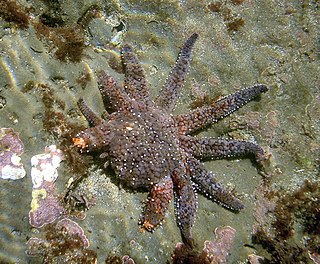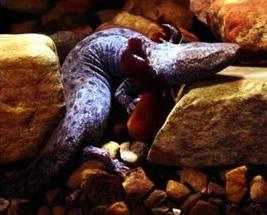Related Research Articles

The hellbender, also known as the hellbender salamander, is a species of aquatic giant salamander endemic to the eastern and central United States. A member of the family Cryptobranchidae, the hellbender is the only extant member of the genus Cryptobranchus. Other closely related salamanders in the same family are in the genus Andrias, which contains the Japanese and Chinese giant salamanders. The hellbender, which is much larger than all other salamanders in its geographic range, employs an unusual means of respiration, and fills a particular niche—both as a predator and prey—in its ecosystem, which either it or its ancestors have occupied for around 65 million years. The species is listed as Near Threatened on the IUCN Red List of Threatened Species.

Salamanders are a group of amphibians typically characterized by a lizard-like appearance, with slender bodies, blunt snouts, short limbs projecting at right angles to the body, and the presence of a tail in both larvae and adults. All present-day salamander families are grouped together under the order Urodela. Salamander diversity is highest in the Northern Hemisphere and most species are found in the Holarctic realm, with some species present in the Neotropical realm.

The African clawed frog is a species of African aquatic frog of the family Pipidae. Its name is derived from the three short claws on each hind foot, which it uses to tear apart its food. The word Xenopus means "strange foot" and laevis means "smooth".

The axolotl, Ambystoma mexicanum, also known as the Mexican walking fish, is a neotenic salamander related to the tiger salamander. Although the axolotl is colloquially known as a "walking fish", it is not a fish, but an amphibian. The species was originally found in several lakes, such as Lake Xochimilco underlying Mexico City. Axolotls are unusual among amphibians in that they reach adulthood without undergoing metamorphosis. Instead of developing lungs and taking to the land, adults remain aquatic and gilled.

The tiger salamander is a species of mole salamander and one of the largest terrestrial salamanders in North America.

The decline in amphibian populations is an ongoing mass extinction of amphibian species worldwide. Since the 1980s, decreases in amphibian populations, including population crashes and mass localized extinctions, have been observed in locations all over the world. These declines are known as one of the most critical threats to global biodiversity.

In biology, regeneration is the process of renewal, restoration, and tissue growth that makes genomes, cells, organisms, and ecosystems resilient to natural fluctuations or events that cause disturbance or damage. Every species is capable of regeneration, from bacteria to humans. Regeneration can either be complete where the new tissue is the same as the lost tissue, or incomplete where after the necrotic tissue comes fibrosis.

Neurulation refers to the folding process in vertebrate embryos, which includes the transformation of the neural plate into the neural tube. The embryo at this stage is termed the neurula.

Waxworms are the caterpillar larvae of wax moths, which belong to the family Pyralidae. Two closely related species are commercially bred – the lesser wax moth and the greater wax moth. They belong to the tribe Galleriini in the snout moth subfamily Galleriinae. Another species whose larvae share that name is the Indian mealmoth, though this species is not available commercially.

In evolutionary developmental biology, heterochrony is any genetically controlled difference in the timing or duration of a developmental process in an organism compared to its ancestors or other organisms. This leads to changes in the size, shape, characteristics and even presence of certain organs and features. It is contrasted with heterotopy, a change in spatial positioning of some process in the embryo, which can also create morphological innovation. Heterochrony can be divided into intraspecific heterochrony, variation within a species, and interspecific heterochrony, phylogenetic variation, i.e. variation of a descendant species with respect to an ancestral species.

The common mudpuppy is a species of salamander in the genus Necturus. They live an entirely aquatic lifestyle in the eastern part of North America in lakes, rivers, and ponds. They go through paedomorphosis and retain their external gills. Because skin and lung respiration alone is not sufficient for gas exchange, mudpuppies must rely on external gills as their primary means of gas exchange. They are usually a rusty brown color and can grow to an average length of 33 cm (13 in). Mudpuppies are nocturnal creatures, and come out during the day only if the water in which they live is murky. Their diet consists of almost anything they can get in their mouths, including insects, mollusks, and earthworms. Once a female mudpuppy reaches sexual maturity at six years of age, she can lay an average of 60 eggs. In the wild, the average lifespan of a mudpuppy is 11 years.
Ribeiroia is a genus of trematode parasites that sequentially infect freshwater snails in the family Planorbidae as first intermediate hosts, fish and larval amphibians as second intermediate hosts, and birds and mammals as definitive hosts. In North America, infection by Ribeiroia has been linked to amphibians with limb malformations. The connection between parasitic infection and limb malformations has generated questions about (a) whether parasite-induced malformations in amphibians are increasing, and (b) the consequences of such abnormalities for amphibian population conservation.

Chytridiomycosis is an infectious disease in amphibians, caused by the chytrid fungi Batrachochytrium dendrobatidis and Batrachochytrium salamandrivorans, a nonhyphal zoosporic fungus. Chytridiomycosis has been linked to dramatic population declines or even extinctions of amphibian species in western North America, Central America, South America, eastern Australia, East Africa (Tanzania), and Dominica and Montserrat in the Caribbean. Much of the New World is also at risk of the disease arriving within the coming years. The fungus is capable of causing sporadic deaths in some amphibian populations and 100% mortality in others. No effective measure is known for control of the disease in wild populations. Various clinical signs are seen by individuals affected by the disease. A number of options are possible for controlling this disease-causing fungus, though none has proved to be feasible on a large scale. The disease has been proposed as a contributing factor to a global decline in amphibian populations that apparently has affected about 30% of the amphibian species of the world. However, recent research has shown that current evidence linking chytrid fungi and chytridiomycosis to global amphibian declines is minimal.
The Puerto Hondo stream salamander or Michoacan stream salamander, Ambystoma ordinarium, is a mole salamander from the Cordillera Volcánica within the Mexican state of Michoacán.

Batrachochytrium dendrobatidis, also known as Bd or the amphibian chytrid fungus, is a fungus that causes the disease chytridiomycosis in amphibians.
Differential adhesion hypothesis (DAH) is a hypothesis that explains cellular movement during morphogenesis with thermodynamic principles. In DAH tissues are treated as liquids consisting of mobile cells whose varying degrees of surface adhesion cause them to reorganize spontaneously to minimize their interfacial free energy. Put another way, according to DAH, cells move to be near other cells of similar adhesive strength in order to maximize the bonding strength between cells and produce a more thermodynamically stable structure. In this way the movement of cells during tissue formation, according to DAH, parodies the behavior of a mixture of liquids. Although originally motivated by the problem of understanding cell sorting behavior in vertebrate embryos, DAH has subsequently been applied to explain several other morphogenic phenomena.

The Panamanian golden frog, also known as Cerro Campana stubfoot toad and other names, is a species of toad endemic to Panama. Panamanian golden frogs inhabit the streams along the mountainous slopes of the Cordilleran cloud forests of west-central Panama. While the IUCN lists it as critically endangered, it may in fact have been extinct in the wild since 2007. Individuals have been collected for breeding in captivity in a bid to preserve the species. The alternative common name, Zetek's golden frog, and the epithet zeteki both commemorate the entomologist James Zetek.
A panzootic is an epizootic that spreads across a large region, or even worldwide. The equivalent in human populations is called a pandemic.
Johannes Holtfreter was a German-American developmental biologist whose primary focus was the “organizer,” a part of the embryo essential for the development of the proper body plan.
Philip Leonard Townes was an American physician, human geneticist, embryologist and developmental biologist who identified Townes-Brocks syndrome in 1972 while a Professor of Pediatrics at the University of Rochester.
References
- Armstrong, J.B., Duhon, S.T., and Malacinski, G.M. (1989) "Raising the axolotl in captivity". In J. B. Armstrong and G. M. Malacinski (eds.) Developmental Biology of the Axolotl. New York: Oxford University Press, pp. 220–227.
| This chemistry-related article is a stub. You can help Wikipedia by expanding it. |